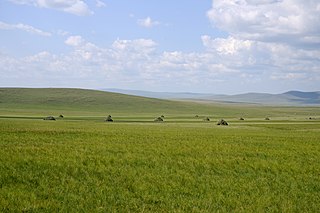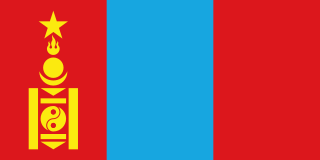21st century
Years in Asia | |
|---|---|
| Sovereign states |
|
| States with limited recognition | |
| Dependencies and other territories | |
This is a list of years in Mongolia . See also Timeline of Mongolian history.

The Mongols are an East Asian ethnic group native to Mongolia, Inner Mongolia in China, and the Buryatia Republic of the Russian Federation. The Mongols are the principal member of the large family of Mongolic peoples. The Oirats in Western Mongolia as well as the Buryats and Kalmyks of Russia are classified either as distinct ethno-linguistic groups or subgroups of Mongols.

Mongolia is a landlocked country in East Asia, bordered by Russia to the north and China to the south. The western extremity of Mongolia is only 37 km (23 mi) from Kazakhstan, and this area can resemble a quadripoint when viewed on a map. It covers an area of 1,564,116 square kilometres, with a population of just 3.3 million, making it the world's most sparsely populated sovereign state. Mongolia is the world's largest landlocked country that does not border a closed sea, and much of its area is covered by grassy steppe, with mountains to the north and west and the Gobi Desert to the south. Ulaanbaatar, the capital and largest city, is home to roughly half of the country's population.

Inner Mongolia, officially the Inner Mongolia Autonomous Region, is an autonomous region of the People's Republic of China. Its border includes two-thirds of the length of China's border with the country of Mongolia. Inner Mongolia also accounts for a small section of China's border with Russia. Its capital is Hohhot; other major cities include Baotou, Chifeng, Tongliao, and Ordos.

Ulaanbaatar, previously anglicized as Ulan Bator, is the capital and most populous city of Mongolia. With a population of 1.6 million, it is the coldest capital city in the world by average yearly temperature. The municipality is located in north central Mongolia at an elevation of about 1,300 metres (4,300 ft) in a valley on the Tuul River. The city was founded in 1639 as a nomadic Buddhist monastic centre, changing location 28 times, and was permanently settled at its modern location in 1778.

Outer Mongolia was the name of a territory in the Manchu-led Qing dynasty of China from 1691 to 1911. It corresponds to the modern-day independent state of Mongolia and the Russian republic of Tuva. The historical region gained de facto independence from Qing China during the Xinhai Revolution.

Mongolian is the principal language of the Mongolic language family that originated in the Mongolian Plateau. It is spoken by ethnic Mongols and other closely related Mongolic peoples who are native to modern Mongolia and surrounding parts of East and North Asia. Mongolian is the official language of Mongolia and Inner Mongolia and a recognized language of Xinjiang and Qinghai.

The Mongolic languages are a language family spoken by the Mongolic peoples in Eastern Europe, Central Asia, North Asia and East Asia, mostly in Mongolia and surrounding areas and in Kalmykia and Buryatia. The best-known member of this language family, Mongolian, is the primary language of most of the residents of Mongolia and the Mongol residents of Inner Mongolia, with an estimated 5.7+ million speakers.

Music is an integral part of Mongolian culture. Among the unique contributions of Mongolia to the world's musical culture are the long songs, overtone singing and morin khuur, the horse-headed fiddle. The music of Mongolia is also rich with varieties related to the various ethnic groups of the country: Oirats, Hotogoid, Tuvans, Darhad, Buryats, Tsaatan, Dariganga, Uzemchins, Barga, Kazakhs and Khalha.

The Mongolian People's Republic was a socialist state that existed from 1924 to 1992, located in the historical region of Outer Mongolia in East Asia. Until 1990, it was a one-party state ruled by the Mongolian People's Revolutionary Party, and maintained close political and economic ties with the Soviet Union, as part of the Eastern Bloc.

The Mongolian People's Party (MPP) is a social democratic political party in Mongolia. It was founded as a communist party in 1920 by Mongolian revolutionaries and is the oldest political party in Mongolia. The party played an important role in the Mongolian Revolution of 1921, which was inspired by the Bolsheviks' October Revolution. Following independence, it governed Mongolia as a one-party socialist state. The party changed its name to the Mongolian People's Revolutionary Party (MPRP) and joined the Communist International in 1924 and served as a sole-ruling party of the Mongolian People's Republic.

Mongolia is divided into 21 provinces or aimags and one provincial municipality. Each aimag is subdivided into several districts. The modern provinces have been established since 1921. The capital, Ulaanbaatar, is governed as an independent provincial municipality separate from Töv Province, inside which it is situated.

The Mongolia national football team represents Mongolia in international football and is controlled by the Mongolian Football Federation.

Buddhism is the largest religion in Mongolia practiced by 51.7% of Mongolia's population, according to the 2020 Mongolia census. Buddhism in Mongolia derives much of its recent characteristics from Tibetan Buddhism of the Gelug and Kagyu lineages, but is distinct and presents its own unique characteristics.

The traditional Mongolian script, also known as the Hudum Mongol bichig, was the first writing system created specifically for the Mongolian language, and was the most widespread until the introduction of Cyrillic in 1946. It is traditionally written in vertical lines Top-Down, right across the page. Derived from the Old Uyghur alphabet, it is a true alphabet, with separate letters for consonants and vowels. It has been adapted for such languages as Oirat and Manchu. Alphabets based on this classical vertical script continue to be used in Mongolia and Inner Mongolia to write Mongolian, Xibe and, experimentally, Evenki.

The Mongolian Revolution of 1990, known in Mongolia as the 1990 Democratic Revolution, was a peaceful democratic revolution which led to the country's transition to a multi-party system. It was inspired by the economic reforms of the Soviet Union in the late 1980s and was one of the many revolutions of 1989. It was led mostly by young demonstrators who rallied at Sükhbaatar Square, in the capital city Ulaanbaatar. The main organisers of the demonstrations included Sanjaasürengiin Zorig, Erdeniin Bat-Üül, Davaadorjiin Ganbold, Tsakhiagiin Elbegdorj, Bat-Erdeniin Batbayar.

The Bogd Khanate of Mongolia was the de facto government of Outer Mongolia between 1911 and 1919 and again from 1921 to 1924. By the spring of 1911, some prominent Mongol nobles including Prince Tögs-Ochiryn Namnansüren persuaded the Jebstundamba Khutukhtu to convene a meeting of nobles and ecclesiastical officials to discuss independence from Qing China. On 30 November 1911 the Mongols established the Temporary Government of Khalkha. On 29 December 1911 the Mongols declared their independence from the collapsing Qing dynasty following the outbreak of the Xinhai Revolution. They installed as theocratic sovereign the 8th Bogd Gegeen, highest authority of Tibetan Buddhism in Mongolia, who took the title Bogd Khan or "Holy Ruler". The Bogd Khaan was last khagan of the Mongols. This ushered in the period of "Theocratic Mongolia", and the realm of the Bogd Khan is usually known as the "Bogd Khanate".
Various nomadic empires, including the Xiongnu, the Xianbei state, the Rouran Khaganate (330–555), the First (552–603) and Second Turkic Khaganates (682–744) and others, ruled the area of present-day Mongolia. The Khitan people, who used a para-Mongolic language, founded an empire known as the Liao dynasty (916–1125), and ruled Mongolia and portions of North China, northern Korea, and the present-day Russian Far East.

Visitors to Mongolia must obtain a visa from one of the Mongolian diplomatic missions unless they are citizens of one of the visa-exempt countries, or citizens who may obtain a visa on arrival, or citizens eligible for an e-Visa.
All visitors must have a passport valid for at least 6 months from the date of arrival.

Tsagaan Khas is a Mongolian neo-Nazi organisation. It was founded by Ariunbold Altankhuum in the 1990s, amid Mongolia's transition to a market economy and the resulting increase in economic inequality.